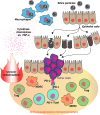Silicosis and lung cancer: current perspectives
- PMID: 30498384
- PMCID: PMC6207090
- DOI: 10.2147/LCTT.S156376
Silicosis and lung cancer: current perspectives
Abstract
"Silica" refers to crystalline particles formed by the combination of silicon with oxygen. Inhalation of silica particles promotes the development of pulmonary fibrosis that over prolonged periods increases the risk of lung cancer. The International Agency for Research on Cancer (IARC) classified crystalline silica as a human carcinogen in 1997. This categorization was questioned due to 1) the absence of dose-response findings, 2) the presence of confounding variables that complicated interpretation of the data and 3) potential selection bias for compensated silicosis. Yet, recent epidemiologic studies strongly support the conclusion that silica exposure increases the risk of lung cancer in humans independent of confounding factors including cigarette smoke. Based on this evidence, the US Occupational Safety and Health Administration (OSHA) lowered the occupational exposure limit for crystalline silica from 0.1 to 0.05 mg/m3 in 2013. Further supporting the human epidemiologic data, murine models show that chronic silicosis is associated with an increased risk of lung cancer. In animals, the initial inflammation induced by silica exposure is followed by the development of an immunosuppressive microenvironment that supports the growth of lung tumors. This work will review our current knowledge of silica-associated lung cancers, highlighting how recent mechanistic insights support the use of cutting-edge approaches to diagnose and treat silica-related lung cancer.
Keywords: fibrosis; inflammation; lung cancer; occupational lung disease; silicosis.
Conflict of interest statement
Disclosure The authors report no conflicts of interest in this work.
Figures


Similar articles
-
Silica: a lung carcinogen.CA Cancer J Clin. 2014 Jan-Feb;64(1):63-9. doi: 10.3322/caac.21214. Epub 2013 Dec 10. CA Cancer J Clin. 2014. PMID: 24327355 Review.
-
Is silicosis required for silica-associated lung cancer?Am J Ind Med. 2000 Mar;37(3):252-9. doi: 10.1002/(sici)1097-0274(200003)37:3<252::aid-ajim2>3.0.co;2-#. Am J Ind Med. 2000. PMID: 10642414 Review.
-
Occupational silica exposure and risk of various diseases: an analysis using death certificates from 27 states of the United States.Occup Environ Med. 2003 Feb;60(2):122-9. doi: 10.1136/oem.60.2.122. Occup Environ Med. 2003. PMID: 12554840 Free PMC article.
-
Lung cancer among silica-exposed workers: the quest for truth between chance and necessity.Med Lav. 2007 Jan-Feb;98(1):3-17. Med Lav. 2007. PMID: 17240640 Review.
-
Pooled exposure-response analyses and risk assessment for lung cancer in 10 cohorts of silica-exposed workers: an IARC multicentre study.Cancer Causes Control. 2001 Nov;12(9):773-84. doi: 10.1023/a:1012214102061. Cancer Causes Control. 2001. PMID: 11714104 Review.
Cited by
-
Three's Company: Coexistence of Silicosis, Scleroderma, and Sjogren Syndrome in a Single Patient.Case Rep Rheumatol. 2022 May 27;2022:4487638. doi: 10.1155/2022/4487638. eCollection 2022. Case Rep Rheumatol. 2022. PMID: 35669457 Free PMC article.
-
A cross-sectional observational study of birefringent particulates in bronchoalveolar lavage cytology in horses with equine asthma from the West v East coasts of the USA.PLoS One. 2024 Apr 4;19(4):e0297181. doi: 10.1371/journal.pone.0297181. eCollection 2024. PLoS One. 2024. PMID: 38573986 Free PMC article.
-
Occupational exposure to respirable crystalline silica among US metal and nonmetal miners, 2000-2019.Am J Ind Med. 2023 Mar;66(3):199-212. doi: 10.1002/ajim.23451. Epub 2023 Jan 27. Am J Ind Med. 2023. PMID: 36705259 Free PMC article.
-
Animal models of silicosis: fishing for new therapeutic targets and treatments.Eur Respir Rev. 2023 Aug 9;32(169):230078. doi: 10.1183/16000617.0078-2023. Print 2023 Sep 30. Eur Respir Rev. 2023. PMID: 37558264 Free PMC article. Review.
-
Interpreting Immunoregulation in Lung Fibrosis: A New Branch of the Immune Model.Front Immunol. 2021 Aug 20;12:690375. doi: 10.3389/fimmu.2021.690375. eCollection 2021. Front Immunol. 2021. PMID: 34489937 Free PMC article. Review.
References
-
- Hessel PA, Gamble JF, Gee JB, et al. Silica, silicosis, and lung cancer: a response to a recent working group report. J Occup Environ Med. 2000;42(7):704–720. - PubMed
-
- Wong O. The epidemiology of silica, silicosis and lung cancer: some recent findings and future challenges. Ann Epidemiol. 2002;12(5):285–287. - PubMed
-
- Leung CC, Yu IT, Chen W. Silicosis. Lancet. 2012;379(9830):2008–2018. - PubMed
-
- Steenland K, Ward E. Silica: a lung carcinogen. CA Cancer J Clin. 2014;64(1):63–69. - PubMed
Publication types
LinkOut - more resources
Full Text Sources

